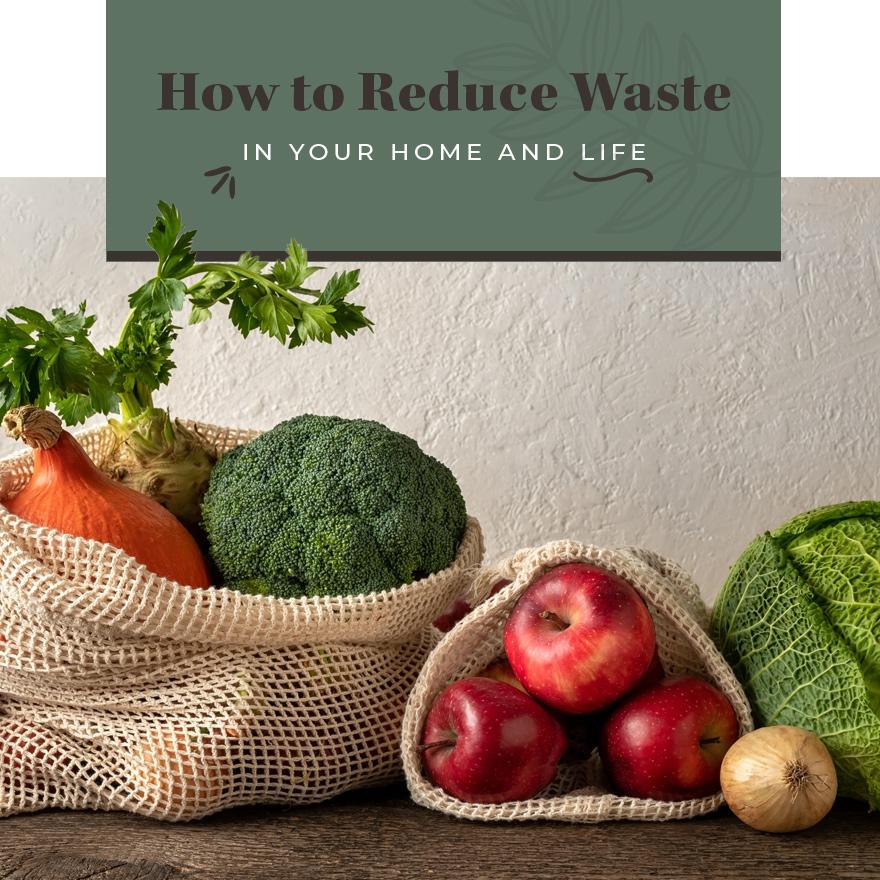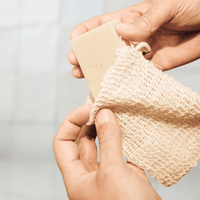
Wondering how you can be less wasteful? You’re not alone. Last year, concerns about climate change reached new heights as we dealt with raging wildfires in California, the busiest hurricane season on record and the knowledge that plastic waste — spurred by the COVID-19 pandemic — is accumulating in landfills and oceans at an alarming pace.
Given these events and the current state of the world, it’s not surprising that more people are embracing the idea of low-waste living. Want to do your part to help the planet and your fellow Earthlings? This simple guide will walk you through how to reduce waste in your day-to-day life, so you can lessen your impact on Mother Earth and start progressing towards a sustainable lifestyle.
THE PROBLEM WITH WASTE: HOW TRASH IMPACTS THE ENVIRONMENT
Since you’re reading this guide, you probably know that waste isn’t good for the environment. But why is it such a big problem? Here are just a few specific areas where our throwaway culture and mounting waste problem are costing us:

- Pollution. Improper waste disposal can cause several types of pollution: air, soil and water. Paper and plastic waste can clog city drains, leading to stagnant water that attracts pests during rainy seasons. Burning piles of trash pump large amounts of greenhouse gases (GHG) into the air, which can harm human lungs. Landfills that are not properly sealed can release a toxic pollutant known as “leachate,” which escapes into the soil and causes health problems for both humans and wildlife.
- Global Climate Change. When food waste ends up at landfills, it releases large amounts of greenhouse gases that trap heat near the Earth’s surface. This raises the global temperature and contributes to extreme weather events, such as bushfires in Australia and wildfires in California.
- Plastics in Oceans. According to the United Nations, more than eight million tons of plastic are dumped in our oceans each year. This plastic poses a serious threat to marine wildlife that may ingest the plastic or become entangled in it. This problem in particular serves as a key motivator for many in the low-waste community, especially after a video of a turtle with a plastic straw stuck in its nose went viral in 2015.
- Loss of Biodiversity. Our waste can also have negative impacts on biodiversity, or the variety of species on Earth. To make room for our growing piles of waste, we destroy natural habitats and use the land as dumping grounds for our trash. Bears and other animals often scavenge through landfills, looking for a tasty meal and ingesting toxic materials instead. Newly-introduced food sources can contribute to the decline of certain species, leading to an uncontrolled population boom in others.
HOW TO REDUCE WASTE: 14 WAYS TO MINIMIZE YOUR WASTE FOOTPRINT

Reducing waste in your home and life doesn’t need to be difficult. It all starts with being more conscious about your impact on the planet. Making even a few small tweaks to your daily routine can make a big difference to the environment, your wallet and your health.
Let’s take action together! From ditching single-use plastics to choosing plastic-free products, here are a few ways to reduce waste in your home and your life.
1. BUY LESS STUFF
Most people make buying decisions out of a desire to possess more things rather than out of any real necessity. This leads to unsatisfactory purchases, duplicate items and excessive amounts of waste.
Before you make a purchase, ask yourself if you truly need it in your life. For example, do you really need the latest iPhone, or will your current smartphone suffice? Simply being mindful of your purchases is usually enough to curb the desire for unnecessary things.
2. AVOID SINGLE-USE PLASTICS
Plastics are piling up in our oceans and landfills at an alarming rate, and single-use plastics are one reason why. Plastic bags, coffee cups, straws, water bottles and other disposable plastics that are meant to be discarded after just one use are incredibly wasteful. Be kinder to the planet (and your wallet) by arming yourself with reusable versions of these items instead.
Not sure where to start? Try tackling the kitchen first. Stainless steel straws, plastic-free dish soap, silicone baking mats, reusable food covers and mesh produce bags are just a few of the many sustainable kitchen products that can help you eliminate waste in your home.

Shop Sustainable Kitchen Products
3. DO A TRASH AUDIT
Before you wheel your trash out to the curb on garbage day, take a peek inside and look at the contents. What do you see? While this exercise may not be the most pleasant, it can be incredibly eye-opening and gives you a good place to start when it comes to reducing your waste.
For example, let’s say that your trash is full of single-serve yogurt cups. To cut down on waste, you could buy a large tub of yogurt and portion out your normal serving sizes. Yes, the container will still eventually become waste, but you’re now creating waste to a much lesser extent. Every little bit helps!
4. CUT BACK ON PRODUCTS THAT USE PLASTIC PACKAGING
Think about how many of the items you buy come in plastic packaging. It’s probably a lot, right? Sadly, most items come in plastic packaging these days. However, there is a surprisingly simple way to avoid unnecessary plastic packaging: just shop the bulk bins.
Granted, many stores are currently limiting access to bulk bins right now due to the pandemic, but it’s worth keeping in mind for when things return to normal. In the meantime, consider supporting brands that provide plastic-free products with zero-waste packaging. Here at The Earthling Co., we wrap our products with all-natural, HOME compostable and biodegradable packaging.
5. GREEN UP YOUR BEAUTY ROUTINE
The bathroom is another hotspot for waste in many American households. From cotton rounds to plastic makeup brushes, many of the beauty products that people use on a daily basis are harmful to the environment.
The good news is that there are plenty of ways to give your beauty routine a sustainable makeover. If you’re looking for an Earthling-friendly upgrade, consider swapping out your bottled shampoo for a plastic-free shampoo bar. Packed with botanical goodness, our shampoo bars are great for your hair, your wallet and the environment.

6. SAY NO TO FAST FASHION
Need to revamp your wardrobe? Avoid shopping at Forever 21, H&M and other fast fashion stores that make super cheap clothing at a rapid pace. While the price tags at these stores may be low, the environmental costs are extremely high. Indeed, the EPA estimates that 13 million tons of clothing and footwear were generated in 2018.
If you need to update your wardrobe on a budget, shopping at second-hand stores is one of the most sustainable ways to do it. Thrift stores are also ideal for finding second-hand furniture and items for your home. Just remember to go in with a plan so you aren’t buying items that you don’t actually need.
7. SHOP AT THE FARMER’S MARKET
Who doesn’t love the farmer’s market? You can buy fresh produce at the peak of growing season and support your local farmers in the process. Best of all, they make it super easy to be low-waste. Not only can you find plastic-free (and chemical-free!) produce, but you can usually reuse containers for eggs and berries by bringing them back to the farmer each week.
8. MEAL PLAN LIKE A PRO
Along with plastic waste, food waste is a big problem in America. Nearly 40 percent of food in America ends up being thrown away, which ultimately turns into methane and contributes to climate change.
Avoid wasting food by planning meals in advance. Though it may seem tedious, planning your meals can go a long way in reducing food waste by helping you make the most of what you already have. It can also save you time and money! Simply set aside a day for planning your meals, grocery shopping and making batches of food. Pop any meals that you don’t eat right away in the refrigerator/freezer.
9. LEARN HOW TO COMPOST
No matter how good you are at meal planning, there are certain parts of food that you’re just not going to eat. Things like orange peels, coffee grounds, nut shells and other food scraps are destined to become food waste, right? Not necessarily. Composting is a great way to minimize your home food waste — and it’s easier than you probably think. If you don’t have the space or the time for a compost garden, consider using a curbside compost service or donating your compost to neighbors and local farmers.

10. GET RECYCLE-SAVVY
While it’s better to view recycling as a last resort option (ideally, you should try to find ways to reduce and reuse items first), it’s important to know how to recycle properly. Recycling can help divert excess waste from landfills and give items a new lease on life.
If you don’t know how to recycle, or you simply want to make sure that you’re doing it correctly, start by looking up your local recycling center website. You’ll get lots of helpful information about recycling in your area. They should be able to tell you what you can and can’t recycle.
11. MAKE YOUR OWN CLEANING PRODUCTS
Cleaning products often have harsh chemicals and almost always come in plastic packaging. As an alternative, consider making your own eco-friendly cleaning products.

Don’t worry, it’s surprisingly easy. In fact, you probably have most of the ingredients you need in your pantry. For example, a dash of lemon, white vinegar, baking soda and warm water are the only ingredients you need to make an effective multi-purpose cleaner.
12. GO DIGITAL
Still getting magazines and bills in the mail? Cancel them and sign up for digital instead. It usually takes less than five minutes to cancel subscriptions and switch to digital-only versions. Sure, opting out of paper junk mail may be a slight inconvenience, but think about how much less paper waste you’ll have — not to mention, how clear your kitchen counter will be!
13. REPURPOSE EVERYDAY ITEMS
Pill bottles. Old t-shirts. Broken furniture. Before you toss out these everyday items, try finding ways to turn your trash into treasure. Also known as “upcycling,” repurposing items can help divert unwanted items from landfills by giving them a new life. For example, you can make dog toys out of old t-shirts. Empty pill bottles can be used to store countless items, including buttons and other sewing supplies. And the potential ways to repurpose broken furniture is practically limitless!
14. SPREAD THE SUSTAINABLE LOVE
Taking good care of the planet needs to be a group effort. To that end, be visible with your sustainable efforts. Start conversations about your low-waste lifestyle and why it’s important to you. Encourage friends and family members to be less wasteful by gifting them sustainable products. Be active in your community and get involved with sustainable causes. Who knows? You could inspire someone to follow in your footsteps and adopt a low-waste lifestyle.

YOUR ACTIONS MAKE A DIFFERENCE
It may take some time to undo the wasteful habits that you learned from a young age — and that’s OK! Remember, you don’t need to be perfect on your low-waste journey. As long as you show up every day and try your best to make the right decision, that’s all that matters.
New to low-waste living and not sure where to begin? The Earthling Co. is happy to help. Browse our entire collection of consciously-sourced, Earthling-friendly, plastic-free products today!
Image Credits
ZUBKOVA IULIIA/shutterstock.com
Tangam/shutterstock.com
Skorzewiak/shutterstock.com
Olga Miltsova/shutterstock.com
Madeleine Steinbach/shutterstock.com
Rawpixel.com/shutterstock.com
Gorlov-KV/shutterstock.com
loreanto/shutterstock.com





